Enabling more trips by bike and micro-mobility devices is essential to reaching Worcester's climate and public health goals. We need to make sure our streets are safe for those who ride today - and for the many more who will choose to ride in the future. The City, through projects initiated by the Department of Transportation & Mobility and the Department of Public Work & Parks, are working to build new high comfort bike and micro-mobility facilities and upgrade existing facilities to be more comfortable.
While each block of safe, comfortable bike and micro-mobility lane is important, it's more important that they connect to each other. A connected network is worth more than the sum of its parts. However, a network is not constructed overnight and each project implemented is working toward the construction of a safe and accessible bike and micro-mobility network that will connect all neighborhoods to their everyday destinations of commercial districts, educational, recreational and health care related facilities throughout the City.
Bike and micro-mobility infrastructure is not one-size-fits-all. The types of facilities constructed on our public streets need to be context sensitive and take into account many different factors and demands on the limited right of way space with the ultimate goal of providing the highest degree of separation and comfort possible. Below is information on different bike and micro-mobility facilities that you can expect to see installed throughout the City of Worcester in the coming years.
Conventional Bike Lanes
Conventional bike lanes are dedicated on-street facilities for cyclists and micro-mobility users. These lanes are adjacent to the vehicle travel lanes and are marked with solid white stripes. Cyclists travel in the same direction as motor vehicle traffic. Conventional bike lanes are typically placed to the right of motor vehicle traffic, between the vehicle travel lane and the curb (or parking), but occasionally may be placed on the left side of the road on a one-way street.
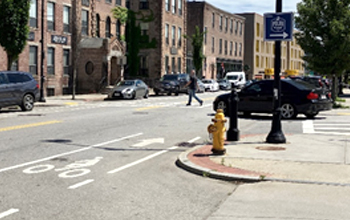
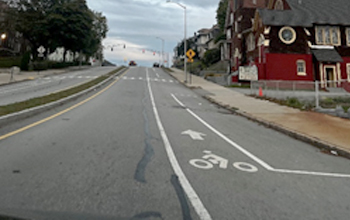
Buffered Bike Lanes
Buffered bike lanes are bike lanes with a painted buffer between the bike lane and an adjacent lane. Most often, the buffer is placed between the bike lane and a travel lane, but may also or instead be placed between the bike lane and an adjacent parking lane. Buffers are typically marked with two white lines and diagonal or chevron markings between the two lines.
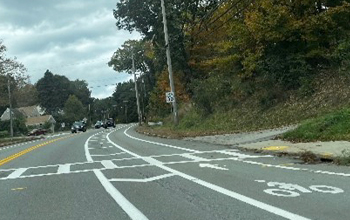
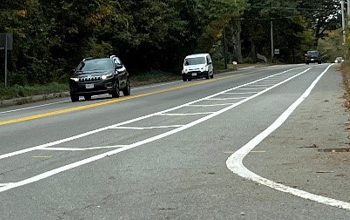
Parking Protected Bike Lanes
Parking protected bike lanes are similar to buffered bike lanes except they are placed between a parking lane and the curb to create additional separation and protection from motor vehicle traffic. Sometimes bollards or other features are used to draw attention to and better demarcate the bike lane and buffer.
Protected Bike Lanes
These bike lanes are typically separated, or protected, from motor vehicle travel lanes with physical elements such as bollards, planters, concrete curbs, etc. and from pedestrians on the sidewalk. These facilities can be designed for one-way or two-way travel, depending on the right of way width.
Shared Use Paths
Shared Use Paths are sidewalk-level biking facilities that are shared with pedestrians. These facilities are adjacent to vehicle travel lanes, without placing cyclists and micro-mobility users directly on the street. Shared Use Paths may also be bidirectional, allowing cyclists to travel in both directions. Cyclists using shared used paths must remain alert to pedestrians and other cyclists.
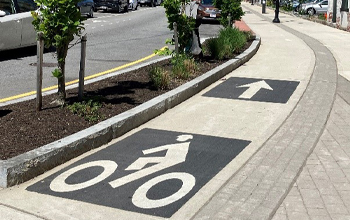
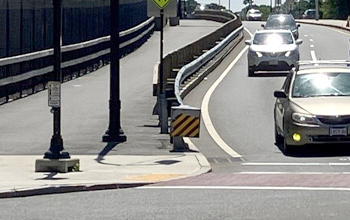
Sharrows
Cyclists and micro-mobility users are permitted to use any roadway except limited access highways. Shared lane markings, commonly called sharrows, are reminders to motorists that bicyclists are allowed to use the full travel lane just like motor vehicle traffic. The markings for a sharrow include a bicycle and two chevrons above the bicycle. Under Massachusetts law, drivers must wait until it is clear to pass a cyclist and provide a safe passing distance of at least 4 feet.
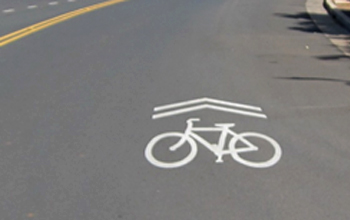
Complete Streets
The Department of Transportation and Mobility takes a Complete Streets approach to designing roadways, which means that the needs of all roadway users and the context of the surrounding neighborhood will be considered during the design phase of a project.
Projects
Every project, whether it is a part of the pavement management program or a full-depth reconstruction of a roadway, is an opportunity to enhance access and safety. More information about how those safety enhancements, including bike lanes, are being incorporated into the City's roadway projects is available on our Projects & Engineering page.
Contact Information
Address
Transportation and Mobility
76 East Worcester Street
Worcester, MA 01604
Contact
Phone: 508-929-1300 ext. 49500
Fax: 508-453-2888
Email Us
Hours
Monday - Friday
8:30 a.m. - 5 p.m.

